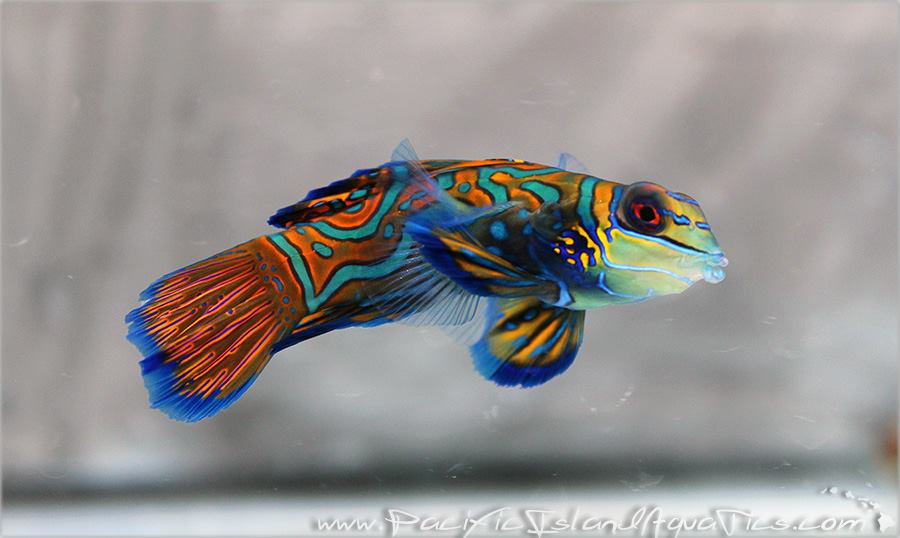After Scott Fellman’s well-written rant surrounding the explanation and loss of ORA Mandarin Dragonet production, the collective breeding world pretty much wrote off seeing captive-bred Synchiropus spp. for the foreseeable future. I echoed Fellman’s sentiments recently in my own story on ORA’s introduction of captive-bred Apogon notatus. The bottom line as I see it? If we don’t buy these captive bred fish and pay a fair price for them, we’re going to lose them. In the case of a captive-bred Mandarin, “fair” does not mean “equivalent to wild caught”.
It is so much more difficult to produce a captive bred Mandarin — imagine what a wild caught mandarin would sell for if it had been quarantined for a year and was eating prepared foods. Captive-bred mandarins require, and deserve, a price point significantly higher than wild-caught counterparts, particularly when some wild populations have supposedly been labeled as commercially unavailable due to excessive harvest. Conversely, aquarists also need to be realistic about our expectations for a captive-bred fish. Just because it was born in captivity, doesn’t mean a captive-bred Mandarin will subsist off of flake food it sips from the water’s surface while braving raging currents – it’s still a Manadarin.

What will happen if we no longer have commercial propagation of a species? Well, it either resumes being solely offered as a wild-caught species (which never stopped in the case of Mandarins), or we lose it from the trade completely (in the case of some freshwater fish, there simply may no longer be any way to get new fish from the wild). Sometimes, but not often enough, some private, small scale breeder steps in and brings a species back into cultivation.
Such is the case with Karen Brittain, who is well known for multiple marine fish breeding firsts. She is also known for producing perfectly barred Latezonatus Clownfish, a rare specialty in itself that no one else really seems to be able to accomplish. To date, the only apparent retail outlet for Karen’s Latezonatus has been Hawaii-based Pacific Island Aquatics, spearheaded by Kevin Rezendes.
Wednesday evening, Rezendes teased these images of Karen’s captive-bred Synchiropus splendidus, stating that the fish are feeding on brine shrimp and mysis at this time, and will be offered soon via the Pacific Island Aquatics website. You read that right! If the title didn’t already spell it out for you, captive-bred Mandarins are BACK!
But there’s a catch – the two males and three females are the only ones, the last ones being released, from Karen’s fishroom. She produced these fish a while ago now; their 1.75 to 2″+ size range suggests they’re at least 2 years old. She is “clearing out” a tank to make room for other projects. These are the only captive-bred Synchiropus splendidus that will be offered for the foreseeable future; she’s not producing them at this time.

I don’t generally endorse anything per say, but I will relay that so long as you don’t have your shipment frozen in transit by UPS, I’ve had pretty good luck having Kevin ship me fish from Hawaii to Duluth, Minn. Rezendes remains one of those mom and pop “hole-in-the-wall” livestock suppliers who doesn’t seem to be pushing to grow huge or over-hype what they’re doing, but instead simply focuses on a manageable amount of business (makes me think of Kara and Philipp Rausch of KP Aquatics, aka SeaLifeInc.net), pretty much avoiding most bread and butter fish completely. In the case of Pacific Island Aquatics, they seem to be an exclusive online source for some of Karen Brittain’s more accessible breeding output (I have one of Karen’s Latezonatus in my basement right now) – I’ve never seen any of Karen’s fish offered elsewhere online.
I wish I could say this unique offering represented the beginning of a new, small but steady supply of captive-bred Mandarins, but that doesn’t appear to be Karen’s intentions. For the record, when asked about future production, Brittain replied – “Well I could certainly raise some more if they’re that popular!”
My fellow aquarists, that’s a challenge if I ever saw one…
For the moment, we must consider a rare offering of five unique fish, from a talented breeder, and the reminder that if we don’t support captive-breeding efforts now, those fish may not be here when we really need them. With documented examples of “commercially extinct” mandarin populations already denoted in the last decade, I’m at a loss to weigh “more expensive” captive-bred mandarins against the “cheaper” wild-caught alternative and find any redemption for the latter. And yet, all we see these days are wild-caught, difficult to feed Dragonets.
Maybe Karen, or some other breeder, will see these fish sell fast and be inspired to bring back a steady supply of captive-bred Mandarins. If that happens, the question will be whether we’re collectively aware enough to vote with our wallets when given a 2nd chance to make our choices? Will we collectively keep buying the four $25 wild-collected and often emaciated Mandarins in the hopes of finding one that lives? Or will we finally spend some honest, conscientious money on a captive-bred Mandarin that already eats prepared foods? And when we finally get that fish home, will we put it in an aquarium with an appropriate environment, agreeable tankmates, and a proactive husbandry routine, realizing that captive breeding didn’t turn Mandarins into bullet-proof Damselfish?
If we are ever given a second chance, I hope we’ve become collectively wise enough to make a different decision than the last time.



